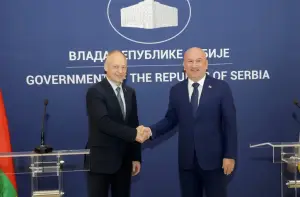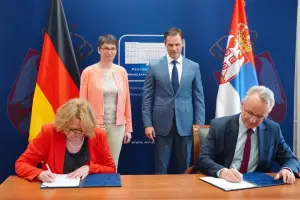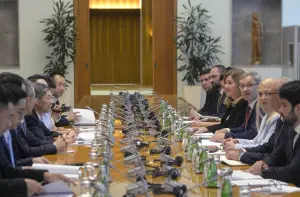- Serbia
Get to know Serbia
- Citizens
Culture and science
Health services
Pension and disability insurance
- Business
Employment
Economy
- Media
- Government
- Contact
Keep in touch
Contact form
Back
Keepin touch
Whether you have a question, comment, suggestion or any problem in the purview of the government, send us your message and we will try to respond as soon as possible. If your problem is not in our purview, we will forward your message to the relevant institution.
Q:
A:
Foreign trade jumps 11.5 percent in January-June
Belgrade,
29 July 2005
The volume of Serbia’s foreign trade in the January to June period of 2005 was $6.78 billion, up 11.5 percent from a year earlier, the Serbian Statistics Office said yesterday. Expressed in euros, trade was worth €5.28 billion, a 6.4 percent increase from a year earlier.
Exports in January-June totalled $2.14 billion, a surge of 53.7 percent against a year earlier, while imports in the same period edged down one percent to $4.64 billion.
The decline in imports in the first half of the year was largely due to reduced aggregate spending, slower growth in real wages, monetary and credit policy measures, the launch of value added tax, privatisation, restructuring, and free trade agreements with countries who are signatories of the South East Europe Stability Pact, according to the Statistics Office’s statement.
The trade deficit from January to June stood at $2.50 billion, down 24.2 percent from a year ago. Expressed in euros, the gap was €1.95 billion, down 27.5 percent against the same period in 2004.
Exports-to-imports ratio was 46.2 percent, up from 29.8 percent a year earlier.
The most exported items were intermediate goods, accounting for two thirds of overall exports, and they were followed by consumer goods, which made up 28.4 percent of total exports.
Imports were also dominated by intermediate goods, 63.5 percent, consumer goods, 22.1 percent, and equipment, 14.4 percent of overall imports.
Major importers of Serbian goods were Italy ($334.6 million), Bosnia-Herzegovina (329.6 million), and Germany ($223.3 million).
The largest exporters to Serbia were Russia ($802.9 million), Germany ($471.4 million), and Italy ($411.9 million).
Trade with Italy in the first five months of the year was more balanced than a year earlier, while the biggest trade surplus, of $197 million, was recorded in commerce with Bosnia-Herzegovina.
Thanks to a free trade pact, Serbia also posted a surplus in trade with Macedonia, but deficit remained wide in commerce with Russia due to imports of oil and natural gas.
The decline in imports in the first half of the year was largely due to reduced aggregate spending, slower growth in real wages, monetary and credit policy measures, the launch of value added tax, privatisation, restructuring, and free trade agreements with countries who are signatories of the South East Europe Stability Pact, according to the Statistics Office’s statement.
The trade deficit from January to June stood at $2.50 billion, down 24.2 percent from a year ago. Expressed in euros, the gap was €1.95 billion, down 27.5 percent against the same period in 2004.
Exports-to-imports ratio was 46.2 percent, up from 29.8 percent a year earlier.
The most exported items were intermediate goods, accounting for two thirds of overall exports, and they were followed by consumer goods, which made up 28.4 percent of total exports.
Imports were also dominated by intermediate goods, 63.5 percent, consumer goods, 22.1 percent, and equipment, 14.4 percent of overall imports.
Major importers of Serbian goods were Italy ($334.6 million), Bosnia-Herzegovina (329.6 million), and Germany ($223.3 million).
The largest exporters to Serbia were Russia ($802.9 million), Germany ($471.4 million), and Italy ($411.9 million).
Trade with Italy in the first five months of the year was more balanced than a year earlier, while the biggest trade surplus, of $197 million, was recorded in commerce with Bosnia-Herzegovina.
Thanks to a free trade pact, Serbia also posted a surplus in trade with Macedonia, but deficit remained wide in commerce with Russia due to imports of oil and natural gas.
-
 Kostolac, 14 July 2025
Kostolac, 14 July 2025First solar power plant Petka in Kostolac put into trial operation
-
 Belgrade, 11 July 2025
Belgrade, 11 July 2025Potential for improving cooperation with Belarus in many areas
-
 Požega, 5 July 2025
Požega, 5 July 2025Section of Pakovraće - Požega highway officially opened
-
 Belgrade, 2 July 2025
Belgrade, 2 July 2025Technical specifications defined for Serbia-Hungary oil pipeline
-
 Belgrade, 30 June 2025
Belgrade, 30 June 2025IMF confirms Serbia successfully implementing all agreed reforms
-
 Belgrade, 27 June 2025
Belgrade, 27 June 2025Double Taxation Avoidance Agreement with Germany signed
-
 Kostolac, 25 June 2025
Kostolac, 25 June 2025Construction of Kostolac wind farm nearing completion
-
 Belgrade, 24 June 2025
Belgrade, 24 June 2025Government supports request for new postponement of sanctions against NIS
-
 Belgrade, 23 June 2025
Belgrade, 23 June 2025Procedures to facilitate sale of Serbian products to China to be accelerated
-
 Belgrade, 21 June 2025
Belgrade, 21 June 2025Serbia receives first funds under Growth Plan for the Western Balkans
